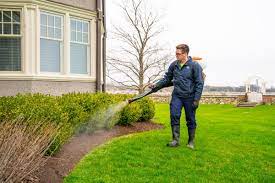Spring Tick Prevention Strategies
As the frost of winter thaws into the warmth of spring, ticks become increasingly active. Since these pests can spread dangerous illnesses like Rocky Mountain spotted fever and Lyme disease, you should prioritize tick protection when organizing your outdoor activities. Employing effective tick control near me techniques is essential in reducing the risk of bites around your home and garden. Begin by cleaning up any outdoor debris where ticks may hide, such as piles of leaves or tall grass. Ensuring these clear areas minimizes tick habitats, reducing their numbers around your property.
Additionally, applying tick repellents to your skin and clothing is crucial when venturing into wooded areas or gardening. Look for repellents containing ingredients proven to repel ticks, such as DEET or picaridin. Tick removal and detection can be facilitated by using light-colored clothes, tucking pants into socks, and wearing long sleeves and pants. After spending time outdoors, it’s prudent to perform regular checks on your pets and family members. Regularly using veterinary-approved tick preventatives is vital for family pets to protect them and yourself from ticks they may carry into your home. These efforts collectively form a first line of defense against these unwanted pests.
Managing Tick Risks in Summer
Summer, a prime time for outdoor fun, also signifies a peak period for tick activity. Increased temperatures and humid conditions create an ideal breeding ground for these pests. Implement a robust outdoor pest control strategy that uses mulch or gravel to create a barrier between your lawn and wooded areas. Mowing your lawn frequently and keeping your landscape tidy reduces hiding spots for ticks, significantly lowering their presence. Consider planting deer-resistant plants, as deer are known to carry ticks onto properties.
During this high-risk season, staying vigilant about protective measures is essential. Using insect repellents containing at least 20% DEET can offer robust protection against ticks. Moreover, encourage family members to change clothes after outdoor activities and shower shortly after that to remove unattached ticks. Familiarize yourself with the signs of tick-borne illnesses to ensure prompt medical attention if necessary. Signs can include flu-like symptoms such as headaches, chills, and muscle aches. Staying informed about local tick activity helps in adopting effective seasonal strategies. For more updated information, check current trends from the CDC, which guide geographical tick prevalence and preventive practices.
Fall: Preparing for Cooler Months
As temperatures begin to dip in the fall, ticks remain active, often seeking a final host before the onset of winter. Contrary to popular belief, fall is not exempt from tick threats. Continue prevention measures by cleaning fallen leaves and clearing brush around your home. These maintenance activities prepare your garden for winter and disrupt tick habitats, forcing them to seek shelter elsewhere, thereby reducing potential encounters.
Utilizing perimeter treatments around your property during late fall can significantly reduce the tick population. This forward-thinking approach can help impede the establishment of a tick population come spring, ensuring a safer environment once temperatures rise again. In addition, remember to inspect firewood, as ticks can easily latch onto pets or humans moving it indoors. Inspect pets regularly as they can be effective carriers, bringing ticks inside from outdoor escapades.
Final Thoughts
Seasonal tick prevention requires an integrated approach that adjusts to the changing environments from spring through fall. Understanding the life cycle of ticks and their active seasons helps tailor prevention measures to be most effective. Remaining aware and proactive with these strategies can vastly diminish the health risks associated with ticks. An ongoing commitment to inspecting and maintaining your yard ensures your home remains a safe and enjoyable haven throughout the year.
Taking these preventative measures seriously can thwart potential tick infestations and safeguard your loved ones against these persistent pests. Engaging in seasonal pest control solutions benefits your immediate surroundings and contributes to community well-being by reducing the overall tick population. Whether through personal vigilance or professional services, sustained efforts can protect your family and neighborhood from the discomfort and dangers of tick-borne diseases. Consistent vigilance ensures that your outdoor activities remain a source of joy and relaxation instead of concern.


